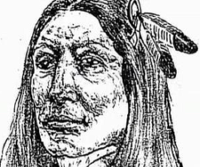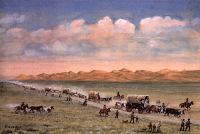Crazy Horse was one of the more famous members of the Oglala Lakota Native American tribe in the 19th Century. He gained great fame for being on the victorious side at the Battle of Little Bighorn. A great and feared warrior, he met an untimely end while resisting capture. 
He was born between 1840 and 1845, near what is now South Dakota, and given the name Tashunka Witco (or Cha-O-Ha). His father, a medicine man, was also known as Crazy Horse, when he was young. One story of his youth tells how the younger Crazy Horse saved his brother from a sudden attack of a bear by swinging a lariat over his head and scaring the bear away. 
Beginning with the California Gold Rush in 1849, Americans in droves rushed westward, in search of a sudden fortune. Some found it, but most did not. Settlement by these white Americans grew in lands in the Midwest already populated by tribes like the Lakota Sioux. Conflicts went from few and far between to frequent, and Crazy Horse developed a reputation as a skilled and fierce warrior, earning the trust of those around him. He also was said to have had visions and to have gone on more than vision quest. Coincidentally or not, his skill in battle was such that he was several times the target of particularly vicious attacks yet remained unscathed. As a leader of a war party, he was often victorious, particularly in what came to be called the Fetterman Massacre. Crazy Horse and a small armed force killed U.S. Army Captain William Fetterman and 80 of his men on Dec. 21, 1866. It was reminiscent of a similar battle 14 years earlier, known as the Grattan Massacre, in which Chief Conquering Bear and many of his Sioux tribe refused to hand over a warrior suspected of killing an American's cow, words were exchanged and then blows, and U.S. Army Lt. John Grattan and his 30 soldiers ended up dead. The devastation of the Fetterman Massacre prompted American forces to negotiate, and the result was the Fort Laramie Treaty, which guaranteed the Black Hills and a large amount of other land to Lakota. Crazy Horse, distrustful and refusing to stop the fight, continued. He wanted Americans off the land that had long belonged to his people, and he was willing to fight to achieve that goal. His distrust was perhaps well placed when the discovery of gold in the Black Hills convinced the U.S. Government to renege on its promise, instead ordering Lakota out of the area and onto reservations. Crazy Horse refused to report as ordered. Another defiant warrior was Sitting Bull, the equally famous and equally powerful Lakota leader. Crazy Horse played a key role in the eventual defeat of the brash General George Armstrong Custer, whom he had encountered earlier, as the leader of a surveying party whose task it was to identify settlement territory in the Black Hills after the announcement of the discovery of gold there. On June 17, 1876, Crazy Horse, at the head of a 1,200-man-strong force of Cheyenne and Oglala, forced a large group of soldiers led by Gen. George Crook to abandon their intended goal of engaging a large force led by Sitting Bull that encamped on the Little Bighorn River. 
Crazy Horse and his men soon joined Sitting Bull and his force, and the two groups joined force to annihilate the smallish Seventh Cavalry led by Custer. At the end of the day at the Battle of Little Bighorn, more than 260 members of the 7th Cavalry, George Armstrong Custer and his brothers Boston and Tom among them, lay dead. No more than 80 Cheyenne and Lakota had died. The sole surviving member of Custer's force was Comanche, a horse. The Battle of Little Bighorn was a total victory for the Native Americans but resulted only in fiercer determination on the part of Americans to claim land in the West. Sitting Bull saw the As in other parts of his life, the stories surrounding Crazy Horse's death are varied and conflicting. He is known to have had an ill wife, and he is thought to have been trying to get her to safety by leaving the fort when he was apprehended and, in an ensuing struggle, stabbed with a bayonet. Another story has Crazy Horse unveiling hidden knives and wounding soldiers, who then retaliated in kind. He is known to have been wounded with a weapon and to have died from that wound. His wife, said to have tuberculosis, outlived him. Crazy Horse died on Sept. 5, 1877. He is revered within his tribe even today as a fierce struggler against the impending wave of American settlement. A remote, sometimes aloof presence when he wasn't raging in battle, Crazy Horse was distrustful of many others, particularly those who wanted to take his picture. No photographs of him are known to exist or to have existed. He was the subject of very few sketches as well, so descriptions of him in words are all that are viably available. He is the subject of a very large monument in South Dakota, which was begun in 1948. |
|
Social Studies for Kids
copyright 2002–2025
David White



 writing on the wall and led a large group of Native Americans into Canada. Crazy Horse was not willing to give up the fight and so stayed and fought. He found himself with fewer and fewer fellow warriors and, in desperation, rode with those left around him to Nebraska's Fort Robinson to surrender. Kept under wraps, he refused an offer of amnesty if he would join the fight against Nez Percé
writing on the wall and led a large group of Native Americans into Canada. Crazy Horse was not willing to give up the fight and so stayed and fought. He found himself with fewer and fewer fellow warriors and, in desperation, rode with those left around him to Nebraska's Fort Robinson to surrender. Kept under wraps, he refused an offer of amnesty if he would join the fight against Nez Percé 
